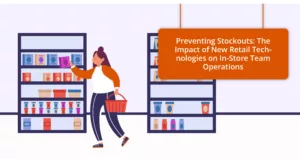The way stock is managed has a direct impact on operational and financial performance. For businesses, navigating between excessive inventory and unmet demand is a constant balancing act, one where every decision counts.
So how can stock be managed like a tightrope walker, without slipping, while keeping costs down? That’s exactly what we’ll explore in this article.
What does the term “stock” actually mean?
In-store stock comes in several forms. Before launching any optimization strategy, it’s essential to understand exactly what type of stock we’re dealing with.
Sales floor stock vs. backroom stock
Sales floor stock refers to items on the shop floor, directly accessible to customers. In contrast, backroom stock refers to items that are stored away from the sales floor and are not accessible to customers, hence the name.
An extension of this backroom stock is what’s known as “overhead stock.” Positioned just above the store shelves, this storage method addresses two key challenges: lack of backroom space and a need for operational efficiency, especially by reducing trips to and from the storage area for fast-moving items.
However, despite its practicality, overhead stock comes with major downsides. It hampers the customer experience by obstructing visibility and creating a sense of clutter. It also disrupts visual merchandising, undermining the store’s aesthetic appeal.
Blurred lines between sales floor and backroom stock
Retailers often face the daily challenge of maintaining a real-time view of both sales floor and backroom stock. Managing precise product locations remains complex, as it requires meticulous logging of every product movement. Still, when well-executed, location management offers better visibility into stock levels by reference and can ease the preparation of online orders.
Whether with or without location-based tracking, stock management relies on the consistent execution of key tasks to document product movements (known shrinkage, damaged items, SKU changes, etc.).
This complexity is also present in specialty retail, though mitigated by the use of RFID technology. Now widely known, RFID offers improved product traceability and makes stock identification easier, whether on the shelf or in the backroom. While common in specialty retail, RFID adoption in food retail remains limited due to its still-high cost.
The hidden costs of inventory management
Overstocking: A significant financial and handling burden
To say that stock is expensive would be an understatement! Between tied-up capital, additional operational costs, and the growing risk of product devaluation, the stakes are high. Every item in storage is, for the time being, unsold. It represents an opportunity cost – capital that could have been allocated to more strategic products.
This is particularly true of dormant stock, which must be identified and closely monitored. Within this category are “at-risk” items, products stored in large quantities with low turnover and “dead stock,” which refers to items that haven’t been sold for a significant period. In these cases, a destocking strategy isn’t just recommended; it’s essential.
That’s exactly why planogram optimization is so crucial. This process helps determine the optimal number of SKUs needed and adjust their stock levels (safety, maximum) based on their strategic importance – such as turnover rate, margin, breadth of offer, supply volatility and substitutability.
Beyond financial concerns, overstock also impacts daily store operations. The more stock there is, the more handling tasks accumulate: repeated back-and-forth trips from the backroom to the shelves, storage headaches, and lost time searching for items. That’s why a simple yet effective rule applies: the less you touch a product, the more you reduce handling time.
Finally, overstock inevitably increases the risk of loss through shrinkage, breakage, or expiry. All these factors undermine the store’s economic performance and logistical efficiency.
Stockouts: A missed opportunity with serious consequences
On the flip side, insufficient stock can have equally damaging effects: immediate revenue loss and a tarnished store image. In 40% of cases, a missing product may be replaced with an equivalent. But in the remaining 60%, the stockout results in a direct, unrecoverable loss. That’s why it’s critical to understand the causes of stockouts and take proactive steps to prevent them. A store that experiences frequent shortages will inevitably frustrate customers, leading to a gradual decline in foot traffic. A risk no company can afford to ignore.
Effectively managing stock is a balancing act between product availability and economic efficiency, in other words, a true high-wire performance.
So how can it be done successfully? Let’s break it down.
Step 1: Give meaning to stock management tasks
It’s essential to give meaning to the tasks involved in stock management. These tasks go well beyond simply placing orders.
First and foremost, teams must be made aware of the importance of conducting stockout checks at strategic times, ideally in the evening, just before closing. This timing provides better insight into root causes (lack of restocking, supplier issues, underordering, etc.). As one of our experts puts it, the goal is to have “the customer’s eyes at closing time.” In contrast, conducting checks at random times during the day leads to imprecise analysis and often results in unnecessary overordering.
It’s also important for team members to understand that every order has an operational impact. A surplus delivery means extra work: products must be shelved, then restocked again later.
Storage organization also plays a key role. A disorganized backroom wastes valuable time, complicates restocking, and prevents accurate visibility into real stock levels.
Lastly, communication among team members is essential, especially when managing promotions. A campaign may change midway, affecting related stock (and possibly leading to overstock).
In short, efficient stock management always starts with simple, well-understood practices.
Step 2: Ensure stock accuracy by breaking bad habits
It’s not uncommon for team members to be wary of Automatic Replenishment Systems (ARS) and prefer manual ordering instead.
The issue? These manual orders are often overestimated, leading to overstocking and unnecessary workloads. And yet, when properly configured, the ARS is both a powerful and reliable tool. The key lies in its setup: accurately defining minimum and maximum stock thresholds for each SKU, and ensuring that stock data is as accurate as possible. A high-performing ARS starts with trustworthy stock data.
Setting the right ARS parameters
To fine-tune ordering parameters for each product, an in-depth understanding of the assortment is essential.
In practice, the ABC method is often used to prioritize products: around 20% of items generate 80% of sales, 30% generate 15%, and the remaining 50% account for only 5%.This classification helps adapt ARS settings according to the strategic importance of each item. High-contribution products (Category A) require more precise parameters and closer monitoring. These are also the items that should be prioritized in cycle counting—because for these key SKUs, stockouts are simply not an option.
Improving stock accuracy
Let’s start with a simple yet realistic principle: your theoretical stock (the one in the system) is likely inaccurate. To correct this and place more accurate orders, certain actions must become routine for store teams.
First, frequent checks must be performed on high-turnover items, especially in the afternoon. This ensures their shelf levels are accurate, prevents stockouts, and confirms that system data used by the ARS reflects reality. Evening stockout reports are also essential.
Another crucial task: regularly checking for negative stock. It’s not uncommon for products to be mislabelled or incorrectly logged. These errors completely disrupt the ARS.
It’s also important to correctly register any items written off as waste, to maintain a stock level that reflects reality.
And while expiry tracking is standard practice for fresh products, dry goods shouldn’t be overlooked. If they expire without anticipation, the risk of stockout becomes very real.
The challenge? These tasks add to an already long list of daily store priorities. Faced with this growing workload, teams can quickly feel overwhelmed, and these crucial actions may be pushed aside, leading to a drop in stock reliability.
That’s precisely when precise activity management becomes indispensable. Not only does it help structure priorities, but it also frees up time that can be reinvested in ensuring consistent, reliable stock control.
Step 3: Stock optimization through activity management
The challenge lies in balancing day-to-day priorities – putting away new deliveries, restocking shelves – with essential yet time-consuming tasks like stock checks and cycle counting.This is precisely where TimeSkipper, a smart activity management platform, comes into play. It helps prioritize tasks while optimizing inventory management. But how exactly does it work?
First, the platform accurately models store activity. It measures the actual workload of each priority task as defined by the store, allowing for a precise estimate of the time required for completion.
Then, by providing a clear view of daily priorities and evenly distributing workload across available staff, TimeSkipper identifies free time slots. These time slots can then be allocated to critical inventory tasks like cycle counts, stockout checks, and negative stock audits.
Additionally, the platform can embed these inventory tasks directly into some employees’ daily schedules, ensuring they are performed regularly.
This way, no task is forgotten. Inventory optimization becomes a continuous and sustainable process. Stockouts and overstock situations are minimized, and customer satisfaction improves. What more could you ask for?
Tracking performance indicators to measure efforts
To effectively measure the impact of efforts made using TimeSkipper, it is crucial to compare the newly dedicated time spent on inventory tasks and their increased regularity with key performance indicators.The platform makes it easy to monitor how proper management of restocking, stockout reporting, and negative stock audits leads to lower stockout rates, shrinkage, breakage, and even reduced stock levels.
By comparing the time invested in inventory-related tasks with these KPIs, teams can quickly assess the effectiveness of implemented processes and make adjustments as needed.This analysis highlights the tangible benefits of a better-structured organization, allowing operational practices to be continuously refined for lasting improvements in inventory management and, by extension, in store performance.
Real-world example: Carrefour Belgium
At Carrefour Belgium, modeling store activity and systematizing stock-related tasks led to a 30% reduction in inventory levels. And that’s just one of many examples.
In summary: better stock optimization, better store performance
Optimizing inventory isn’t about applying a magic formula, it’s about executing a series of rigorous, repeatable actions that become part of the team’s daily routine. By structuring priorities, ensuring data accuracy, and managing tasks through tools like TimeSkipper, stores can optimize their stock every day and strengthen their supply chain resilience.
So, are you ready to take control of your inventory?






